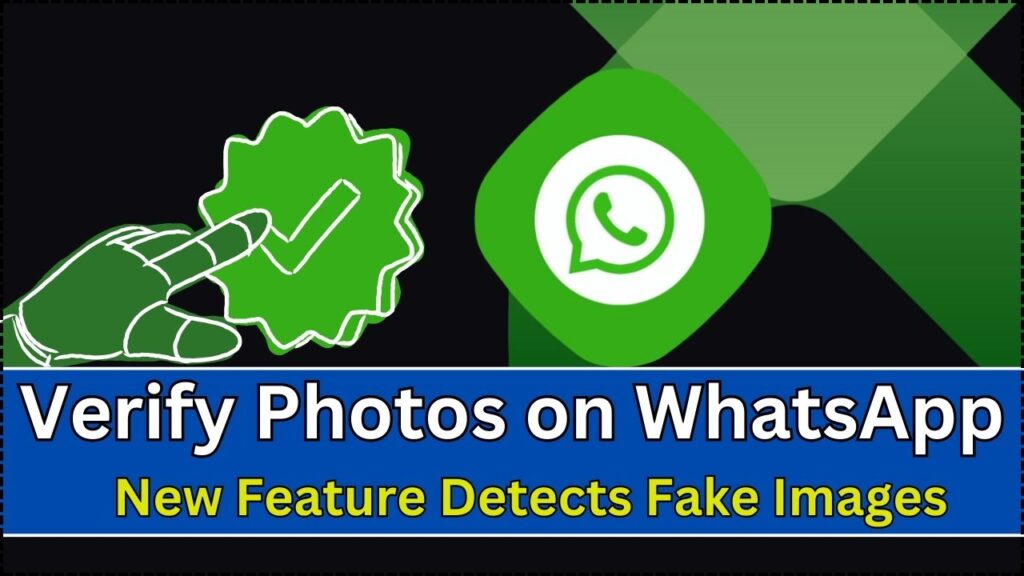
Verify Photos on WhatsApp: Misinformation is one of the biggest challenges in the digital age, and WhatsApp, a popular messaging platform with over 2 billion users, is stepping up to tackle it. The app has introduced a revolutionary feature to help users verify photos shared on the platform—making it easier than ever to detect fake images with just one click.
This new functionality, called the “Search on Web” feature, integrates seamlessly into WhatsApp’s existing interface, empowering users to reverse-search images directly within the app. Whether you’re a curious user trying to trace the origin of an image or a professional safeguarding against misinformation, this feature is a game-changer.
WhatsApp’s innovative approach addresses one of the most pressing issues of the digital era. By incorporating reverse image search capabilities, the platform not only enhances user experience but also builds trust within its global community. This feature is particularly vital as the dissemination of fake visuals becomes increasingly sophisticated.
Verify Photos on WhatsApp
| Feature | Details |
|---|---|
| Feature Name | Search on Web |
| Purpose | Detect fake images and verify authenticity |
| How It Works | Reverse image search via Google |
| Availability | Currently for beta users (Android version 2.24.23.13); wider rollout soon |
| Privacy Assurance | WhatsApp does not store or process uploaded images |
| Official Source | WhatsApp Help Center |
WhatsApp’s “Search on Web” feature is a timely addition in the fight against misinformation. By providing users with a quick and reliable way to verify images, the platform empowers individuals to make informed decisions and share responsibly. Whether you’re a casual user or a professional, this tool offers immense value in today’s information-driven world.
With this feature, WhatsApp not only enhances its functionality but also contributes to a broader effort to curb the spread of false information. It’s a step forward for digital literacy and a more trustworthy online experience.
Why Is the “Search on Web” Feature Important?
The internet is brimming with content, and not all of it is accurate. In fact, studies show that false information spreads six times faster than the truth on social media (source: MIT). Fake images, doctored photos, and misleading visuals have contributed significantly to misinformation campaigns. For example:
- Election misinformation: Photoshopped images can mislead voters about candidates, influence public opinion, and skew election results.
- Scams: Fraudulent images of fake giveaways, job offers, or lotteries are often used to deceive people into sharing personal information or making payments.
- Health misinformation: Images with false claims about medical treatments or remedies can lead to harmful outcomes and panic.
The “Search on Web” feature allows users to take control of the content they consume and share, significantly reducing the chances of being misled. It’s an essential tool for anyone who values accuracy and reliability in their communications.
Moreover, businesses and institutions can benefit from this feature by maintaining credibility and ensuring that their messaging is not inadvertently associated with false information.
How Does the Verify Photos on WhatsApp Feature Work?
The “Search on Web” feature is designed for simplicity and ease of use. Here’s a step-by-step guide:
Step 1: Open the Image
When you receive an image on WhatsApp, tap on it to view it in full-screen mode. This enables you to access additional options for handling the photo.
Step 2: Access the Menu
Click on the three-dot menu icon located in the top-right corner of the screen. This opens a dropdown menu with various options, including the “Search on Web” feature.
Step 3: Select “Search on Web”
From the dropdown options, select “Search on Web.” This triggers the image verification process.
Step 4: Confirm the Action
WhatsApp will prompt you to confirm the search. Once approved, the app will upload the image to Google’s reverse image search tool. This step ensures that users are aware of the process and provides an opportunity to cancel if desired.
Step 5: Analyze Results
The search results will display matching or similar images online. By reviewing these results, you can trace the origin and context of the photo, determine its authenticity, and identify whether it has been altered or misrepresented.
Privacy Concerns: Is Your Data Safe?
One question users often ask is, “Will WhatsApp store my photos?” The answer is no. WhatsApp has clarified that the “Search on Web” feature uses a direct connection to Google’s reverse image search and does not store or process your photos on its servers. This assurance aligns with WhatsApp’s end-to-end encryption policy, ensuring your privacy remains intact.
Additionally, Google’s search process is designed to provide results without compromising the user’s personal data. This double layer of privacy protection ensures that the feature is both secure and effective.
Practical Applications While Using Verify Photos on WhatsApp Feature
For Individuals
- Verify Viral Images: Quickly check if that sensational image circulating in your groups is genuine. For example, you can identify if a dramatic weather photo is real or digitally enhanced.
- Prevent Scams: Authenticate images linked to suspicious offers or claims. For instance, you can verify whether a promotional image promising free smartphones is legitimate.
- Educational Purposes: Use the feature to teach children about critical thinking and digital literacy. This helps younger generations develop skills to identify misleading content.
For Professionals
- Journalists: Confirm the authenticity of images used in reports or articles. This is critical in maintaining journalistic integrity and preventing the spread of false narratives.
- Marketers: Ensure visuals used in campaigns are original and not misleading. For instance, you can check if stock photos have been altered or reused without permission.
- Law Enforcement: Identify sources of fake images in cases involving cybercrime or digital fraud. This feature can be an invaluable tool in forensic investigations.
Tips for Using “Search on Web” Effectively
- Be Skeptical: Always question the source and intent of an image. Ask yourself why the image was shared and whether it aligns with credible information.
- Consider Context: Verify not just the photo but also its caption and context. Sometimes, accurate images are paired with misleading text to distort their meaning.
- Cross-Verify: Use additional tools like TinEye or other reverse image search platforms for comprehensive checks. Combining multiple sources increases the reliability of your findings.
- Educate Others: Share the feature with friends and family to promote responsible sharing practices. Creating awareness about misinformation can help build a more informed community.
WhatsApp Rolls Out Document Scanning Feature: How to Use It on Your iPhone
ChatGPT Now on WhatsApp: Revolutionizing Conversations with AI!
Apple’s 2025 Intelligence Features: How They’ll Redefine Technology
FAQs About Verify Photos on WhatsApp
1. Who can access the “Search on Web” feature?
Currently, the feature is available to select beta testers using WhatsApp on Android (version 2.24.23.13). A global rollout is expected in the coming months. iOS users can anticipate similar updates in the near future.
2. Is the feature free to use?
Yes, the “Search on Web” feature is completely free for all WhatsApp users. There are no hidden charges or subscription requirements.
3. Can I use it for all images?
Yes, the feature works for any image shared on WhatsApp, provided you have an active internet connection. However, images that are highly edited or unique may yield less comprehensive results.
4. Will my data be shared with third parties?
No, WhatsApp does not store or process your images. The search is conducted directly via Google, ensuring that your privacy is respected throughout the process.
5. What should I do if the results are inconclusive?
If the search doesn’t yield clear results, consider using additional verification methods or consulting trusted sources. For critical situations, reaching out to experts may provide further clarity.








